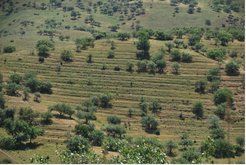Anthropogenic Landscapes of the Silk Road
The landscape of Inner Asia may seem ‘wild’ and untamed, however, it is the direct product of thousands of years of human occupation. People have altered the land for farming and herding and harvested the forests for fuel and lumber, ultimately reshaping every ecosystem. Central Asia expresses extreme ecological variability across space and also through time; with increasing paleoecological investigation, it is becoming clear that humans played a direct role in shaping this variability. Over the past several millennia, humans have adapted to the diversity and unpredictability of the region, and in the process they have reshaped the landscape.

Data are illustrating how biologically different the foothills of Central Asia were in the past; the forests that once covered much of the foothill ecotone played an important role in early human occupation. These wild fruit and nut forests provided foraged and hunted food for early settlers, and the rich ecological pockets in river valleys have been and still are key to pastoral grazing. In addition, many of the familiar fruit and nuts that we cultivate today, such as the apple and pistachio, originated in these now largely lost shrubby forests.
As scholars study the archaeology and paleoenvironments of Central Asia, it is becoming increasingly clear how closely intertwined humans were with the evolution of the landscape. The gradual deforestation of the mountain foothills of Central Asia seems to reflect an intensification of human economy, especially surrounding intensive metal smelting. Humans have continued to shape the landscape of Central Asia since the fourth millennium B.C., clearing land for herd pastures, opening up river valleys for farming, and harvesting wood resources for fuel and lumber. The biotic landscapes of Central Asia are a direct artifact of prehistoric humans, and these anthropogenic ecosystems illustrate part of the story of the Silk Road.
